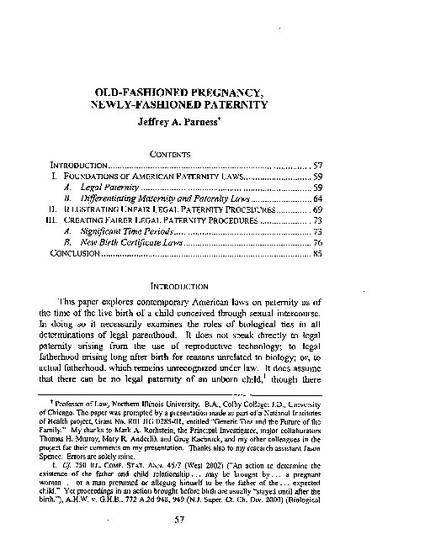
This paper explores contemporary American laws on paternity as of the time of the live birth of a child conceived through sexual intercourse. In doing so it necessarily examines the roles of biological ties in all determinations of legal parenthood. It does not speak directly to legal paternity arising from the use of reproductive technology; to legal fatherhood arising long after birth for reasons unrelated to biology; or, to actual fatherhood, which remains unrecognized under law. It does assume that there can be no legal paternity of an unborn child, though there certainly may be prospective legal paternity that prompts parental-like status for pregnant dads. And, it does recognize there can be both retroactive legal paternity and presumptive legal paternity. In the former, paternity based upon biology is established long after birth, but relates back in time to the date of birth. In the latter, there is a presumption of paternity at the time of birth that usually assumes, but need not actually involve (as with marriage), biological ties. For men, legal paternity designations may result in parental rights or responsibilities. These rights can involve such matters as childrearing, monetary recovery under tort or probate laws, or child visitation. These responsibilities can involve such matters as child support or special duties under tort or criminal laws. For children, legal paternity designations usually provide rights, if not responsibilities. Children's rights can include child support as well as special protections under tort, probate, or criminal laws. In exploring legal paternity, the paper necessarily examines differences in assigning parental rights and parental responsibilities, though recognizing that the two often go hand-in-hand. As well, it explores differences guiding legal maternity and legal paternity determinations. The major thesis of the paper is that old-fashioned pregnancies require newly-fashioned paternity laws. Consideration of new laws is facilitated by advances in scientific testing. Law reform is necessary because existing laws too often mistreat dads by unfairly eliminating paternal rights or unfairly assigning paternal responsibilities. The chief concerns here are with the procedures, not with the substantive norms, employed by American governments, usually states, for designating legal paternity. The chief goal is to promote legal paternity designations "consistent with orderly procedure without unnecessary involvement in procedural quirks, complications and limitations."